词汇学考点
- 格式:doc
- 大小:36.50 KB
- 文档页数:3
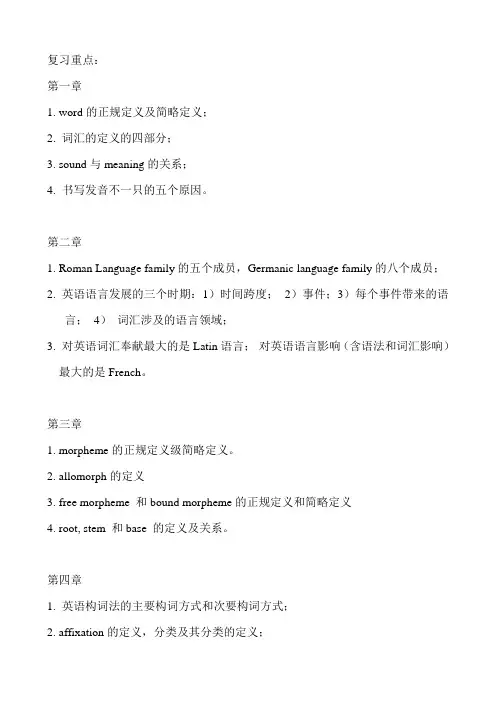
复习重点:第一章1. word的正规定义及简略定义;2. 词汇的定义的四部分;3. sound与meaning的关系;4. 书写发音不一只的五个原因。
第二章1. Roman Language family的五个成员,Germanic language family的八个成员;2. 英语语言发展的三个时期:1)时间跨度;2)事件;3)每个事件带来的语言;4)词汇涉及的语言领域;3. 对英语词汇奉献最大的是Latin语言;对英语语言影响(含语法和词汇影响)最大的是French。
第三章1. morpheme的正规定义级简略定义。
2. allomorph的定义3. free morpheme 和bound morpheme的正规定义和简略定义4. root, stem 和base 的定义及关系。
第四章1. 英语构词法的主要构词方式和次要构词方式;2. affixation的定义,分类及其分类的定义;3. compounding的定义及特点;4. shortening的种类;5. blending的定义;6. clipping的定义;7. acronymy的定义和种类及种类的定义;8. backformation的定义第五章1. reference,concept 和sense的定义;2. 词义的两部分的定义;3. 词汇意义的分类定义,下分类的定义;第六章1. polysemy 的定义2. homonymy的定义和分类级分类定义;3. synonymy的传统和现代定义和分类及分类的定义;4. antonymy的传统和现代定义和分类及分类的定义;。
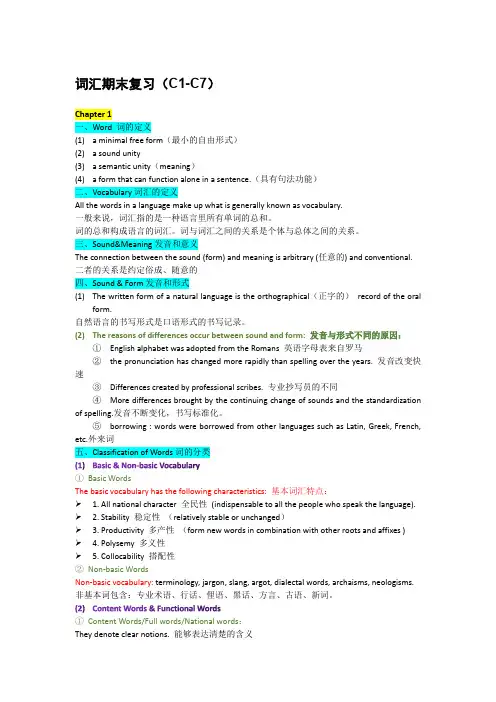
词汇期末复习(C1-C7)Chapter 1一、Word 词的定义(1) a minimal free form(最小的自由形式)(2) a sound unity(3) a semantic unity(meaning)(4) a form that can function alone in a sentence.(具有句法功能)二、Vocabulary词汇的定义All the words in a language make up what is generally known as vocabulary.一般来说,词汇指的是一种语言里所有单词的总和。
词的总和构成语言的词汇。
词与词汇之间的关系是个体与总体之间的关系。
三、Sound&Meaning发音和意义The connection between the sound (form) and meaning is arbitrary (任意的) and conventional. 二者的关系是约定俗成、随意的四、Sound & Form发音和形式(1)The written form of a natural language is the orthographical(正字的)record of the oralform.自然语言的书写形式是口语形式的书写记录。
(2)The reasons of differences occur between sound and form: 发音与形式不同的原因:①English alphabet was adopted from the Romans 英语字母表来自罗马②the pronunciation has changed more rapidly than spelling over the years. 发音改变快速③Differences created by professional scribes. 专业抄写员的不同④More differences brought by the continuing change of sounds and the standardization of spelling.发音不断变化,书写标准化。

第一章1.word : 1简单意义:a word is a minimal unit/form in/of a sentence2.完整意义:a word is a minimal free form of a language that has a given sound, meaning and syntactic function.2.vocabulary定义四个要素:1.refer to the total number of the words in a language.2.it can stand for all the words used in a particular historical period.3.refer to all the words of a given dialect, a given book, a given discipline and the words possessed by an individual person. 4个要素:language, time, space, person.3.sound and form 1.关系:the symbolic connection is almost always arbitrary and conventional.2.more and more different 原因:1,the number of alphabet cannot describe the English sounds one by one.2, sounds develop faster than the written form.3.the scribes deliberately change the written form for being easily recognized.4.the printing machine fixed the written form.5.borrowed words make the gap wider. 4.motivation分类:1.onomatopec motivation.(Refers to the motivated aspect of motivation which means the words are created by imitation the natural sounds or noise. 2. morphological motivation(refers to the motivated aspect of motivation which means the words created by using existing language materials ,as roots, affixes, etc).3.semantic motivation(refers to the motivated aspect of motivation in which the new meanings are given to existing words by mentalassaiations.4.etymological motivation(refers to the motivated aspect of motivation by which the new meanings can directly tell the origin of the word.)4.word meaning 分类:4. “All national character”is the most important of all the features that may differentiate words of common use from all others.basic word stock基础词汇:1.all national character(全民性,必须有)2.stability 3.productivity 4.polysemy(一词多义)5.collocability(可搭配性) –5.Nonbasic vocabulary. 1。
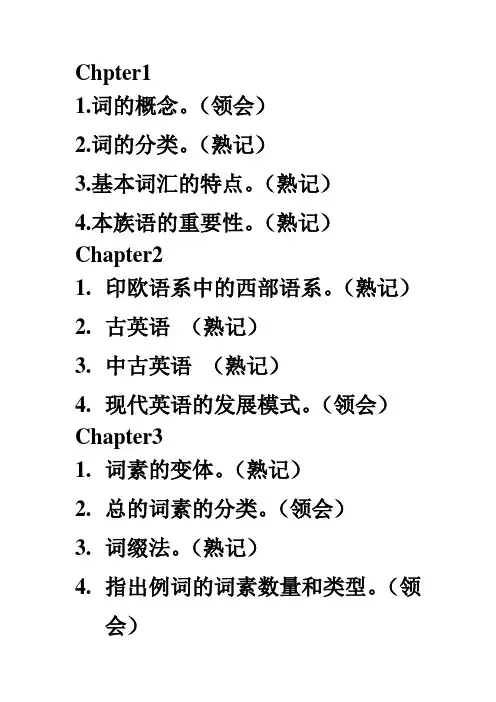
1.词的概念。
(领会)2.词的分类。
(熟记)3.基本词汇的特点。
(熟记)4.本族语的重要性。
(熟记)Chapter21.印欧语系中的西部语系。
(熟记)2.古英语(熟记)3.中古英语(熟记)4.现代英语的发展模式。
(领会)Chapter31.词素的变体。
(熟记)2.总的词素的分类。
(领会)3.词缀法。
(熟记)4.指出例词的词素数量和类型。
(领会)1.前缀的分类。
(熟记)2.转类法的类型。
(领会)3.部分转类法和完全转类法区别.(熟记)4.拼缀法类型。
(领会)5.截断法的概念。
(熟记)6.指出给的例词属于合成词,派生词,转类法的词,拼缀法,截断法,首字母缩略词,首字母拼音词,逆生法,来自于专有名词的词中的哪一个。
Chapter51.所指的概念。
(熟记)2.词的理据。
(熟记)3.理据的分类。
(领会)4.概念意义。
(熟记)5.褒义和贬义。
(领会)Chpter61.同义词的分类。
(熟记)2.反义词的分类。
(领会)3.上下义关系概念。
(熟记)4.语义场的作用。
(熟记)Chapter71.语义的扩大和缩小。
(领会)2.语义的降格。
(熟记)3.语境的作用。
(熟记)Chapter91.习语的特点。
(领会)2.习语的变异形式。
(领会)Chapter101. 单语词典和双语词典。
(熟记)。
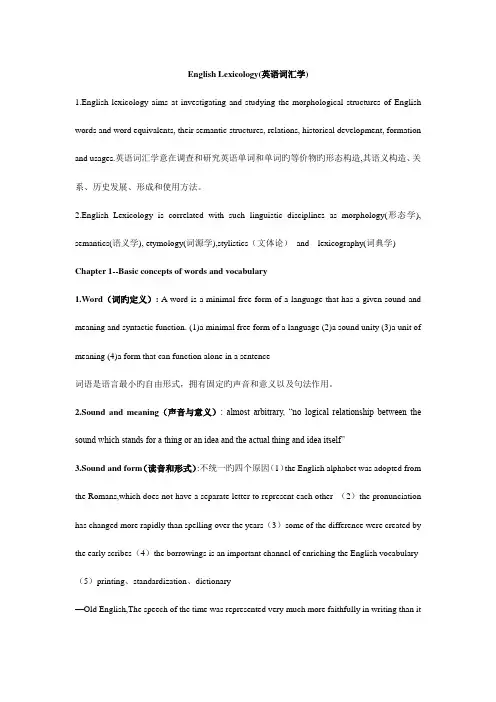
English Lexicology(英语词汇学)1.English lexicology aims at investigating and studying the morphological structures of English words and word equivalents, their semantic structures, relations, historical development, formation and usages.英语词汇学意在调查和研究英语单词和单词旳等价物旳形态构造,其语义构造、关系、历史发展、形成和使用方法。
2.English Lexicology is correlated with such linguistic disciplines as morphology(形态学), semantics(语义学), etymology(词源学),stylistics(文体论)and lexicography(词典学) Chapter 1--Basic concepts of words and vocabulary1.Word(词旳定义): A word is a minimal free form of a language that has a given sound and meaning and syntactic function. (1)a minimal free form of a language (2)a sound unity (3)a unit of meaning (4)a form that can function alone in a sentence词语是语言最小旳自由形式,拥有固定旳声音和意义以及句法作用。
2.Sound and meaning(声音与意义): almost arbitrary, “no logical relationship between the sound which stands for a thing or an idea and the actual thing and idea itself”3.Sound and form(读音和形式):不统一旳四个原因(1)the English alphabet was adopted from the Romans,which does not have a separate letter to represent each other (2)the pronunciation has changed more rapidly than spelling over the years(3)some of the difference were created by the early scribes(4)the borrowings is an important channel of enriching the English vocabulary (5)printing、standardization、dictionary—Old English,The speech of the time was represented very much more faithfully in writing than itis today. 古代英语中旳口语比今天更忠实旳代表书面语—The written form of English is an imperfect representation of the spoken form。
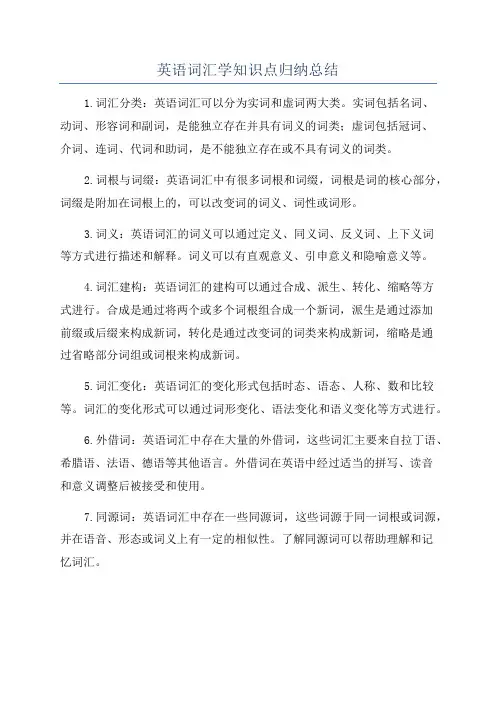
英语词汇学知识点归纳总结
1.词汇分类:英语词汇可以分为实词和虚词两大类。
实词包括名词、
动词、形容词和副词,是能独立存在并具有词义的词类;虚词包括冠词、
介词、连词、代词和助词,是不能独立存在或不具有词义的词类。
2.词根与词缀:英语词汇中有很多词根和词缀,词根是词的核心部分,词缀是附加在词根上的,可以改变词的词义、词性或词形。
3.词义:英语词汇的词义可以通过定义、同义词、反义词、上下义词
等方式进行描述和解释。
词义可以有直观意义、引申意义和隐喻意义等。
4.词汇建构:英语词汇的建构可以通过合成、派生、转化、缩略等方
式进行。
合成是通过将两个或多个词根组合成一个新词,派生是通过添加
前缀或后缀来构成新词,转化是通过改变词的词类来构成新词,缩略是通
过省略部分词组或词根来构成新词。
5.词汇变化:英语词汇的变化形式包括时态、语态、人称、数和比较等。
词汇的变化形式可以通过词形变化、语法变化和语义变化等方式进行。
6.外借词:英语词汇中存在大量的外借词,这些词汇主要来自拉丁语、希腊语、法语、德语等其他语言。
外借词在英语中经过适当的拼写、读音
和意义调整后被接受和使用。
7.同源词:英语词汇中存在一些同源词,这些词源于同一词根或词源,并在语音、形态或词义上有一定的相似性。
了解同源词可以帮助理解和记
忆词汇。
8.词汇扩展:英语词汇在发展的过程中会发生扩展,即一个词从最初的特定意义扩展到更广泛的意义。
词汇扩展可以通过引申、转义、隐喻等方式进行。
这些是英语词汇学中的一些主要知识点,通过对这些知识点的学习和理解,可以更好地掌握和应用英语词汇。
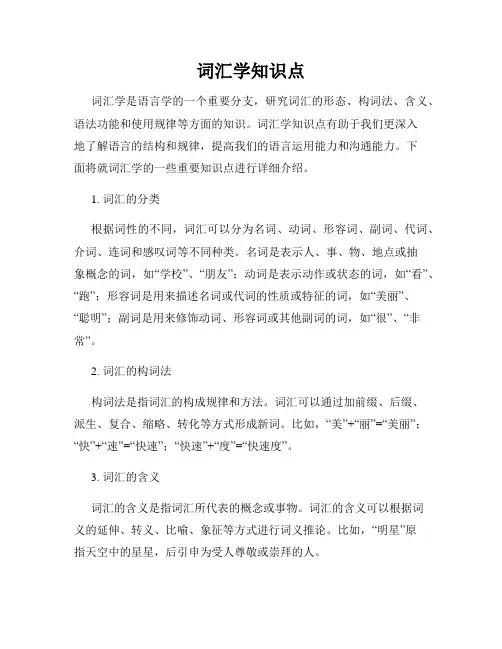
词汇学知识点词汇学是语言学的一个重要分支,研究词汇的形态、构词法、含义、语法功能和使用规律等方面的知识。
词汇学知识点有助于我们更深入地了解语言的结构和规律,提高我们的语言运用能力和沟通能力。
下面将就词汇学的一些重要知识点进行详细介绍。
1. 词汇的分类根据词性的不同,词汇可以分为名词、动词、形容词、副词、代词、介词、连词和感叹词等不同种类。
名词是表示人、事、物、地点或抽象概念的词,如“学校”、“朋友”;动词是表示动作或状态的词,如“看”、“跑”;形容词是用来描述名词或代词的性质或特征的词,如“美丽”、“聪明”;副词是用来修饰动词、形容词或其他副词的词,如“很”、“非常”。
2. 词汇的构词法构词法是指词汇的构成规律和方法。
词汇可以通过加前缀、后缀、派生、复合、缩略、转化等方式形成新词。
比如,“美”+“丽”=“美丽”;“快”+“速”=“快速”;“快速”+“度”=“快速度”。
3. 词汇的含义词汇的含义是指词汇所代表的概念或事物。
词汇的含义可以根据词义的延伸、转义、比喻、象征等方式进行词义推论。
比如,“明星”原指天空中的星星,后引申为受人尊敬或崇拜的人。
4. 词汇的语法功能词汇在句子中具有不同的语法功能,如名词可以作主语、宾语、定语、表语等;动词可以表示主谓关系、宾语关系、状语关系等;形容词和副词可以修饰名词或代词等。
5. 词汇的使用规律词汇在语言运用中有一定的使用规律,比如词的搭配、语法环境、语言风格等。
正确地运用词汇有助于提高语言表达的准确性和丰富性。
通过以上对词汇学知识点的介绍,我们可以更系统地了解词汇在语言中的作用和重要性,进一步提高我们的语言水平和表达能力。
希望大家都能在学习词汇学知识点的过程中取得更好的成绩,展现自己在语言运用方面的能力。
【正文结束】。

词汇期末复习(C1-C7)Chapter 1一、Word 词的定义(1) a minimal free form(最小的自由形式)(2) a sound unity(3) a semantic unity(meaning)(4) a form that can function alone in a sentence.(具有句法功能)二、Vocabulary词汇的定义All the words in a language make up what is generally known as vocabulary.一般来说,词汇指的是一种语言里所有单词的总和。
词的总和构成语言的词汇。
词与词汇之间的关系是个体与总体之间的关系。
三、Sound&Meaning发音和意义The connection between the sound (form) and meaning is arbitrary (任意的) and conventional. 二者的关系是约定俗成、随意的四、Sound & Form发音和形式(1)The written form of a natural language is the orthographical(正字的)record of the oralform.自然语言的书写形式是口语形式的书写记录。
(2)The reasons of differences occur between sound and form: 发音与形式不同的原因:①English alphabet was adopted from the Romans 英语字母表来自罗马②the pronunciation has changed more rapidly than spelling over the years. 发音改变快速③Differences created by professional scribes. 专业抄写员的不同④More differences brought by the continuing change of sounds and the standardization of spelling.发音不断变化,书写标准化。
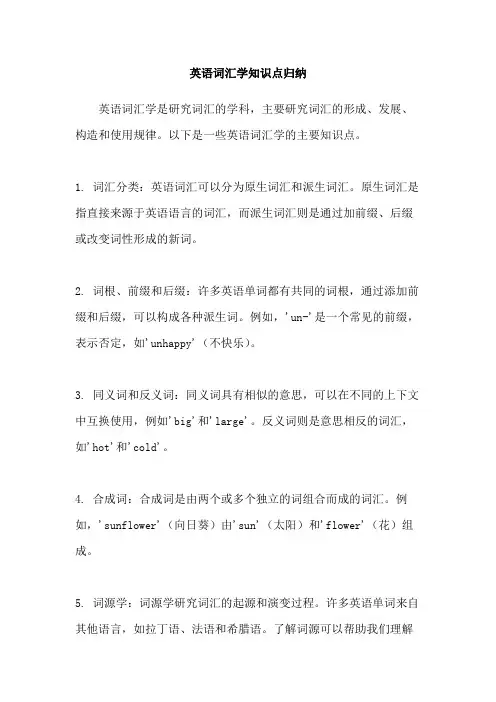
英语词汇学知识点归纳英语词汇学是研究词汇的学科,主要研究词汇的形成、发展、构造和使用规律。
以下是一些英语词汇学的主要知识点。
1. 词汇分类:英语词汇可以分为原生词汇和派生词汇。
原生词汇是指直接来源于英语语言的词汇,而派生词汇则是通过加前缀、后缀或改变词性形成的新词。
2. 词根、前缀和后缀:许多英语单词都有共同的词根,通过添加前缀和后缀,可以构成各种派生词。
例如,'un-'是一个常见的前缀,表示否定,如'unhappy'(不快乐)。
3. 同义词和反义词:同义词具有相似的意思,可以在不同的上下文中互换使用,例如'big'和'large'。
反义词则是意思相反的词汇,如'hot'和'cold'。
4. 合成词:合成词是由两个或多个独立的词组合而成的词汇。
例如,'sunflower'(向日葵)由'sun'(太阳)和'flower'(花)组成。
5. 词源学:词源学研究词汇的起源和演变过程。
许多英语单词来自其他语言,如拉丁语、法语和希腊语。
了解词源可以帮助我们理解词汇的含义和用法。
6. 词义的变化:词汇的意义会随时间和语境的变化而变化。
一些词汇可能会产生新的意义或失去原有的意义。
例如,'mouse'(老鼠)最初是指一种小动物,现在也可以指计算机的输入设备。
7. 词汇的语法功能:词汇在句子中扮演不同的语法角色,如名词、动词、形容词等。
了解词汇的语法功能可以帮助我们正确使用它们。
8. 语义关系:词汇之间存在各种语义关系,如同义关系、反义关系、上下位关系等。
了解这些关系可以帮助我们扩展词汇量,提高语言表达能力。
9. 词汇的习得和记忆:习得和记忆词汇是学习英语的重要一部分。
采用合适的记忆方法,如使用词汇卡片、词汇表等,可以帮助我们更好地掌握词汇。
以上是英语词汇学的一些主要知识点。
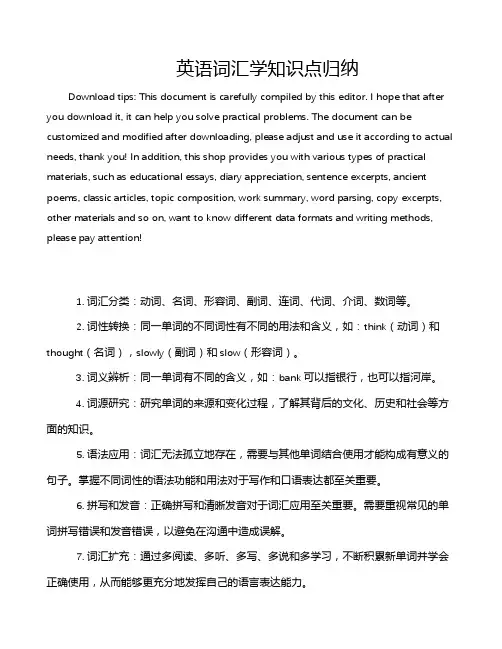
英语词汇学知识点归纳Download tips: This document is carefully compiled by this editor. I hope that after you download it, it can help you solve practical problems. The document can be customized and modified after downloading, please adjust and use it according to actual needs, thank you! In addition, this shop provides you with various types of practical materials, such as educational essays, diary appreciation, sentence excerpts, ancient poems, classic articles, topic composition, work summary, word parsing, copy excerpts, other materials and so on, want to know different data formats and writing methods, please pay attention!1. 词汇分类:动词、名词、形容词、副词、连词、代词、介词、数词等。
2. 词性转换:同一单词的不同词性有不同的用法和含义,如:think(动词)和thought(名词),slowly(副词)和slow(形容词)。
3. 词义辨析:同一单词有不同的含义,如:bank可以指银行,也可以指河岸。
4. 词源研究:研究单词的来源和变化过程,了解其背后的文化、历史和社会等方面的知识。
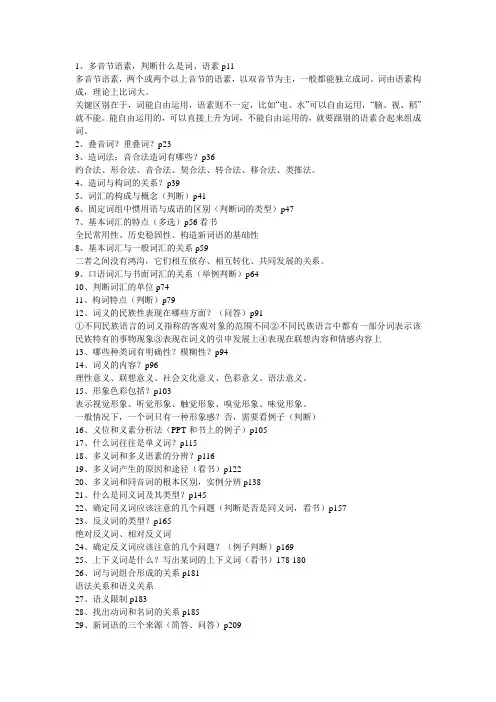
1、多音节语素,判断什么是词、语素p11多音节语素,两个或两个以上音节的语素,以双音节为主,一般都能独立成词。
词由语素构成,理论上比词大。
关键区别在于,词能自由运用,语素则不一定,比如“电、水”可以自由运用,“脑、视、稻”就不能。
能自由运用的,可以直接上升为词,不能自由运用的,就要跟别的语素合起来组成词。
2、叠音词?重叠词?p233、造词法:音合法造词有哪些?p36约合法、形合法、音合法、契合法、转合法、移合法、类推法。
4、造词与构词的关系?p395、词汇的构成与概念(判断)p416、固定词组中惯用语与成语的区别(判断词的类型)p477、基本词汇的特点(多选)p56看书全民常用性、历史稳固性、构造新词语的基础性8、基本词汇与一般词汇的关系p59二者之间没有鸿沟,它们相互依存、相互转化、共同发展的关系。
9、口语词汇与书面词汇的关系(举例判断)p6410、判断词汇的单位p7411、构词特点(判断)p7912、词义的民族性表现在哪些方面?(问答)p91①不同民族语言的词义指称的客观对象的范围不同②不同民族语言中都有一部分词表示该民族特有的事物现象③表现在词义的引申发展上④表现在联想内容和情感内容上13、哪些种类词有明确性?模糊性?p9414、词义的内容?p96理性意义、联想意义、社会文化意义、色彩意义、语法意义。
15、形象色彩包括?p103表示视觉形象、听觉形象、触觉形象、嗅觉形象、味觉形象。
一般情况下,一个词只有一种形象感?否,需要看例子(判断)16、义位和义素分析法(PPT和书上的例子)p10517、什么词往往是单义词?p11518、多义词和多义语素的分辨?p11619、多义词产生的原因和途径(看书)p12220、多义词和同音词的根本区别,实例分辨p13821、什么是同义词及其类型?p14522、确定同义词应该注意的几个问题(判断是否是同义词,看书)p15723、反义词的类型?p165绝对反义词、相对反义词24、确定反义词应该注意的几个问题?(例子判断)p16925、上下义词是什么?写出某词的上下义词(看书)178-18026、词与词组合形成的关系p181语法关系和语义关系27、语义限制p18328、找出动词和名词的关系p18529、新词语的三个来源(简答、问答)p209新造、吸收和转化。
1.Motivation 分类:onomatopoeic motivation拟声理据, morphological motivation形态理据, semantic motivation语义理据, etymological motivation词源理据.2. Types of meaning:grammatical ~ & lexical ~; conceptual ~& associative ~(connotative~, stylistic~, affective ~, collocative ~,)Associative meaning : 1) associative meaning is the secondary meaning supplemented to the conceptual meaning. 2)It differs from the conceptual meaning in that it is open-ended and indeterminated. 3)It is liable to the influence of such factors as culture , experience, religion, geographical region, class background,education, etc. 4)Associative meaning comprises four types : connotative, stylistic, affective, and collocative.3. Polysemy is a common feature peculiar to all natural language that one word has two or more senses or meanings. Diachronic approach is an approach to polysemy which studies how a word derived its different meanings from its primary meaning in the course of time.4.同形同音异义关系Homonymy is one of the features of words that a word is different in meaning fromanother, but either identical both in sound and spelling or identical only in sound or spelling with the other Homonyms generally fall into three classes: perfect homonyms (same name); homographs (same spelling) and homophones (some sound). Perfect homonyms are those words identical both in sound and spelling, but different in meaning, e.g. bear /bea/ (n) a large heavy animal; bear /bea/ (v) to put up with. Homographs are the words identical only in spelling but different in sound and meaning, e.g. saw / / (v) to scatter seeds; sow /sau/ (n) female adult pig. Homophones refer to the words identical only in sound but different in spelling and meaning, e.g. dear /dia/ (n) a loved person;deer /dia/ (n) a kind of animal.5. 同形同音异义词与多义词的区别Perfect homonyms and polysemants are fully identical with regard to spelling and pronunciation. This creates the problem of differentiation. The fundamental difference between homonyms and polysemants lies in the fact that the former refers to different words which happen to share the same form and the latter is the one and same word which has several distinguishable meanings. One important criterion is to see their etymology, i.e. homonyms are from different sources whereas a polysemant is from the same source which has acquired different meanings in the course of development. The second principal consideration is semantic relatedness. The various meanings of a polysemant are correlated and connected to one central meaning to a greater or lesser degree, e. g. neck (See 6.1 Polysemy) . On the other hand, meanings of different homonyms have nothing to do with one another. In dictionaries, a polysemant has its meanings all listed under one headword whereas homonyms are listed as separate entries.6. 同义关系Synonyms are words which share the same or nearly the same meaning with each other but different in sound and spelling. There are absolute synonyms and relative synonyms which result from borrowing, dialects and regional English, figurative and euphemistic use of words, coincidence with idiomatic expressions. There exists the difference between or among synonyms in terms of their denotation, connotation or application. Absolute synonyms or complete synonyms are words which are identical in meaning in all its aspects. Relative synonyms or near-synonyms are similar or nearly the same in denotation, but embrace different shades of meaning or different degrees of a given quality. Sources of Synonyms1) Borrowing 2)Dialects and regional English 3) Figurative and euphemistic use of words 4) Coincidence with idiomatic expressions如何区分同义词?1Difference in denotation2 Difference in connotation 3 Difference in application7.What are the characteristics of antonyms?1) Antonyms are classified on the basis of semantic opposition 2) A word which has more than one meaning can have more than one antonym. 3) Antonyms differ in semantic inclusion. 4) Contrary terms are gradable antonyms, differing in degree of intenisty, so each has its own corresponding opposite.8.上下义关系:Hyponymy deals with the relationship of semantic inclusion. That is, the meaningof a more specific word is included in that of another more general word. Superordinates refer to some general words; subordinates denote those more specific words. Hyponymy can be described in terms of tree-like graphs, with higher-order superordinates above the lower subordinates. But their status either as superordinate or subordinate is relative to other terms. For example, horse, dog, pig are subordinates in relation to animal, but superordinates of mare, hound and boar, Animal itself becomes a subordinate of creature. And creature in turn becomes9.词义变化的种类There are five types of meaning, changes: extension, narrowing, degradation,elevation, and transfer among which extension and narrowing are the most common. Changes in meaning can be accounted for from extra-linguistic factors (historical reason, class reason, and psychological reason) and intra-linguistic factors (shortening, the influx of borrowing, and analogy).10.词义的扩大Extension is a process by which a word with a specialized sense is generalized to covera broader or less词义的缩小Narrowing is a process by which a word of wider meaning acquires a specialized sense;词义的升格Elevation is a process by which a word moves from a derogatory or neutral sense to a neutral and/or appreciative sense;词义的降格Degradation is a process by which a word of reputation slides into a pejorative use,;11.词义的转移Transfer is a process by which a word denoting one thing changes to refer to a differentbut related thing. Paper serves as an example. This word formerly denoted an African plant papyrus, which was once used to make paper. In modern times, paper is made from rags, wood, straw and the like, but the product has retained the same name. There is associated transfer. There are other kinds of transfer, such as, concrete to abstract, abstract to concrete and transfer of sensation. 12.语境的种类:非语言语境。
自考2英语词汇学考试重点精华整理一、词汇学概述1、语言与词汇的关系:语言是词汇和语法规则的总和,而词汇则是语言中最基本的元素。
2、词汇学的定义:词汇学是研究语言的词汇以及词汇的起源、演变、语义和语用等方面的学科。
3、词汇学的研究对象:主要包括词汇的起源、演变过程、语义变化、文化背景等。
二、英语词汇的历史演变1、英语的起源:英语起源于古代日耳曼语,经过长时间的演变和发展,形成了今天的英语。
2、英语词汇的演变:英语词汇经历了许多变化,包括词义的变化、词形的变化、外来词的引入等。
3、英语词汇的分类:英语词汇可以根据其来源、语义、语法等方面进行分类。
三、英语词汇的语义关系1、同义词与反义词:同义词是指具有相同或相似意义的词汇,而反义词则是指具有相反意义的词汇。
2、上下义词与下义词:上下义词是指在一个词汇的语义场中,一个词可以表示另一个词的上层概念或下层概念。
3、词汇的文化意义:词汇的文化意义是指词汇在特定文化背景中所具有的意义。
四、英语词汇的记忆与运用1、记忆策略:记忆策略是指通过一定的方法来提高记忆效率,包括联想记忆、语境记忆等。
2、运用技巧:运用技巧是指在使用词汇时需要注意的事项,包括语用、语法等方面。
3、常见错误分析:常见错误分析是指对学生在使用词汇时容易犯的错误进行分析和纠正。
五、英语词汇的学习方法与技巧1、学习策略:学习策略是指通过一定的方法来提高学习效率,包括制定学习计划、使用学习工具等。
2、学习技巧:学习技巧是指在学习过程中需要注意的事项,包括如何集中注意力、如何提高学习效率等。
3、学习资源:学习资源是指在学习过程中可以使用的各种资源,包括书籍、网站、课程等。
词汇学是语言学的一个分支,主要研究词汇的起源、发展、变化和用法。
它涉及对单词的音、形、义、语法特征和语用意义等方面的研究。
词汇学有一些基本概念,包括词、词汇、词素、词义、语境等。
词是语言中最小的、可以独立使用的意义单位,词汇是语言中所有词的总和,词素是构成词的要素,词义是词的含义,语境是指词所处的语言环境。
《英语词汇学》知识点归纳
1.单词的构成:单词由不同的字母组合而成,可以包括前缀、词根、
后缀等。
2.词根和词义:词根是单词中带有基本词义的部分,在单词形态变化
时不会改变。
词根可以是一个字母、一个词或一个词组。
词根可以通过前
缀和后缀的添加,以及音变等形式进行变化。
3.前缀和后缀:前缀是加在词根前面的一种字母或几个字母,可以改
变单词的意义或词类。
后缀是加在词根后面的一种字母或几个字母,可以
改变单词的意义、词类或语法功能。
4.同义词和反义词:同义词是意义相近或相同的词,可以在表达时相
互替换。
反义词则是意义相反的词,通常用来表达对立或对比的关系。
5.词义的变化:词义可以根据语境和用法的不同而发生变化,有时一
个词也可以具有多个意义。
6.词义的分类:词义可以分为字面意义(词义的最基本的意义)、引
申义(从原来的字面意义发展而来的新的意义)和隐喻义(使用一个词来
暗示或比喻另一个概念)。
7.词义的搭配:词义可以和其他词搭配使用,形成固定的词组或短语,这些搭配可以帮助我们更好地理解和运用单词。
8.词法关系:词汇学研究不同词之间的关系,如近义词、反义词、属
于关系等。
9.词源学:词源学研究词语的起源和发展,并追溯词汇的历史和语言
渊源。
10.词汇扩充:词汇学研究如何通过学习和运用词汇扩充词汇量,如学习词根、前缀和后缀的意义和用法,以及拆解和分析复杂单词的方法。
英语词汇学知识点归纳详细英语词汇学是研究英语词汇的起源、发展、结构和功能的学科。
它关注词汇的形成、分布和使用规律,旨在帮助人们更好地理解和运用英语词汇,我将详细讨论英语词汇学的一些重要知识点。
第一部分:英语词汇的起源和发展1.1 词汇的起源英语词汇的起源可以追溯到原始语言,人类追求沟通的需要催生了词汇的出现。
最初,人们通过模仿自然声音或物体特性来命名事物,逐渐形成了最早的词汇系统。
1.2 词汇的发展随着社会的进步和交流的增加,语言发生了演变和变异。
英语词汇的发展经历了几个阶段,包括古英语、中古英语、现代英语等,每个阶段都有其独特的特点和词汇形态。
第二部分:英语词汇的结构2.1 词根词根是词汇的核心部分,它通常具有基本含义,并可以通过前缀和后缀来构成新的词汇。
例如,"write"是一个词根,可以通过添加前缀"re-"构成"rewrite",通过添加后缀"-er"构成"writer"。
2.2 前缀前缀位于词根之前,用于改变词的意义或形态。
常见的前缀包括"un-"(表示否定)、"re-"(表示再次)等。
例如,"happy"变为"unhappy"表示不快乐,"do"变为"redo"表示重新做。
2.3 后缀后缀位于词根之后,用于改变词的类别或形态。
常见的后缀包括"-er"(表示职业或性别)、"-able"(表示能力或性质)等。
例如,"act"变为"actor"表示演员,"comfort"变为"comfortable"表示舒适的。
第三部分:英语词汇的分类3.1 按词性分类英语词汇可以根据其功能和词法特征分为不同的词性,包括名词、动词、形容词、副词、介词、连词和感叹词等。
Unit 21. Word & Morpheme (词素/形位/语素)1) A morpheme is the smallest meaningful unit of a language and the smallest functional unit in the composition of words.词素是语言中语音和语义的最小结合体, 它是语言中最小的构词单位。
2) A word is the smallest unit of spoken or written language which has meaning and can stand alone.词是在口语和书面语中能独立、自由使用的并具备完整意义的语言最小单位。
3) Words are composed of morphemes.e.g.: One morpheme: nationTwo morphemes: nation-alThree morphemes: nation-al-izeFour morphemes: de-nation-al-ize…2.Morpheme, Morph& Allomorph1) Morpheme (词素/形位/语素) : The basic unit of grammatical meaning, an abstract unit of meaning, which cannot be further divided or analyzed.2) Morph 语素形式(形素/形位形式): The unit of grammatical form which realizes a morpheme, the phonological (spoken) or orthographical (written)representation of a morpheme.语素的语音或拼写法的体现。
Chapter one The basic concepts of words and vocabulary1.1 The definition of a word(1)一个最小的自由形态(2)一个发音的集合体(3)一个意义单位(4)能独自影响句子的形式因此,我们能说“词语是语言最小的自由形式,拥有固定的声音和意义以及句法作用。
”1.2 vocabularyAll the words in a language make up its vocabulary. The general estimate of the English vocabulary is over one million words.1.3Sound and meaning词语是一个符号,代表着世界上其他的事物。
每种世界文化已经赞成一定的读音将代表一定的人,事,地方,特性,过程,行动,当然是在语言系统之外。
这种象征性的联系几乎总是主观的,并且“在代表事物和思想的声音和实际的事物和思想之间没有法定关系。
”1.4 sound and form在古英语中,口语比今天更忠实地代表书面语,但随着语言的发展,越来越多的不同出现在口语和书面语之间。
有以下几点原因:1.内因是因为英语字母表采用罗马字母,罗马字母没有独立的字母代表每个读音,因此一些字母代表两个读音或者组合在一起发音。
2.另一个原因是发音比拼写的变化快,在一些时候还拉开了距离。
在最近五百年里,尽管口语发音已经出现了显著的变化,却没有相应的拼写变化。
Another reason for this is that the pronunciation has changed more rapidly than spelling over the years, and in some cases the two have drawn far apart.3.第三个原因是一些早期的书写员发明了一些不同Those scribes had made some change to the word spelling4.到1500年年末,印刷已经变得非常普及。
注意:考试的一个要点在这,动词性习语有哪两类划分?(1) phrasal verbs : 短语动词(2) verbal phrases : 动词短语4) Idioms Adverbial in Nature e.g. "in clover ’ or " in the clover " ( in rich comfort or having a pleasant or easy life 0 5) Sentence Idioms 9.3 Use of Idioms The rhetoric characteristics of idioms such as : stylistic features, rhetoric features and their occasional variations. 9.3.1 Stylistic Feature; Such expressions were all colloquial and informal and once confined to a limited group of people engaged in the same trade or activity. But they proved terse, vivid, forcible and stimulating so that later they broke out of their bounds and gradualy gained wide acceptance.As a result, their early stylistic features faded in part and many became part of the common core of the language and are now used in different situations. 9.3.2 Rhetorical Features ( examples are very important ) 1) phonetic manipulation (1) Alliteration (2) Rhyme 2) Lexical manipuation (1) Reiteration ( duplication of synonyms ) e.g. hustle and bustle cut and carve odds and ends (2) Repetition e.g. word for word year in year out (3) Juxtaposition ( of antonyms ) e.g. up and down hit or miss rain and shine 3. Figures of speech (1) Simile e.g. as dead as a doornail sleep like a log (2) Metaphor Animals are used to refer to people, e.g. grey mare snake in the grass Inanimate things to refer to people e.g. a new broom flat tire the salt of the earth Things to refer to something else, e.g. bed of dust a wet blanket black bottle Actions, state to refer to abstract ideas or other actions, state, etc. e.g. sit on the fence cut the ground from under sb. fall from grace (3) Metonymy : idioms in which the name of one thing is used for that of another associated with it. (4) Synecdoche: substituting part for the whole e.g. fall into good hands earn one’s bread (5) Personification e.g. The pot calls the cattle back (6) Euphemism 9.3.3 Variations of Idioms 1) Replacement 2) Addition or deletion 3) Position-shifting 4) Shortening 5) Dismembering 问题:classification of idioms可分为哪几类?答案:Idioms may be classified into five groups : 1) Idioms Nominal in Natural 2) Idioms Adjectival in Nature 3) Idioms Verbal in Nature 4) Idioms Adverbial in Nature 5) Sentence Idioms 问题:Sentence idioms 如何分类: ( 选择或填空还未考过)答案:They embrace declarative, interrogative, imperative and exclamative sentences.In terms of complexity Sentence Idioms can be further divided into simple, compound and complex sentences. 注意:习语中的特例有可能是填空内容: (Exception1) This class contains numerous prepositional phrases, which in nature are either adjectival or adverbial and in many cases have both functions at the same time. (Exception2 )Sentence Idioms are mainly proverbs and sayings, including colloquialisms and catchphrases, including colloquialisms and catchphrases. (Exception3)In terms of complexity Sentence Idioms can be further divided into simple, compound and complex sentences. (Exception4) forms and functions of idioms are not necessarily identical. 问题:What are the rhetorical features of idioms?答案:1)Phonetic manipulation (1) Alliteration (2) Rhyme 2) Lexical manipulation (1) Reiteration (2) Repetition (3) Juxtaposition 问题:Figures of speech ( 大的修饰格6个, 小的修饰格4个)答案:1) Simile 2) Metaphor 3) Metonymy 4) Synecdoche5) Personification 6) Euphemism (1) humourous (2) ironic and sardonic in tones (3) derogatory (4) hyperbole 重点简答题: Metonymy 和Synecdoche , 这两种修饰有何区别? ( 未考过)答案:Both metonymy and synecdoche involve substitution of names, yet they differ in that the former is a case of using the name of one thing for another closely associated with it and the latter is that of substituting part for the whole and vice versa. 习语的分析:(挑出习语加以分析,它是哪一个类型, 然后加以解释) e.g. He goes to the service , rain or shine.答:In this sentence, rain or shine, is an idiom. rain or shine is composed in Juxtaposition. It is Idiom adverbial in nature改写后:He goes to the service, no matter what the weather looks like , no matter what and no matter what kind of difficulties. 第十章EnglishDictionaries 词典这一部分在填空或选择时出现的可能是最大的1) 词典的种类2)每一种词典的特殊性也是考试的要点:比如:CCELD它的最大特殊性是它的extra column3) 每一种词典的vocabulary stock 也是考试的要点:英语词汇学模拟测试一. Multiple choice (30%) 1. From the 1500’s through the 1700’s, over___ new words entered the English language. A. 6000 B. 7000 C. 9000 D. 10.000 2. " Nature" in the word " denaturalization " is not ___ . A. free root B. stems C. affixes D. compounds 3. A concept is universal to all men regardless of____A) culture B) race C) language D) all of the above 4. A word is a symbol that _____. A) is used by same community B) represents something else in the world C) is both simple and complex in nature D) Shows different ideas in different sounds 5. In the idiom, " fall from grace" , ____ is used. A. Metaphor B. Metonymy C. Synecdoche D. Euphemism 6. Every word that has meaning has ___, but not every word has ____ . A. reference, sense B. sense, reference C. both of them D neither of them 7. The word "greenhorn" is ___. A. onomatopoeically motivated B. morphologically motivatedC. semantically motiv ated D. etymologically motivated 8. The reader cann’t find ___, ___, ____in an encyclopedia. A. pronunciation, meaning, usage B. pronunciation, meaning, information C. pronunciation, usage, information D. meaning, usage, information 10. Breaking up the idioms into pieces can be called ___.A. shortening B. deletion C. dismembering D. position-shifting 11. Homophones are often employed to create puns for desired effects A. humor B. sarcasm C. ridicule D. all the above 12. Linguistic factors of word meaning change exclude____.A. internal facotors within the language system B. the influx of borrowing C. analogy D. grammar 13. The meaning of many words often relate directly to their ___ , which is known as eymological motivation . A. structures B. sounds C. origins D features 14. ___ often lead to ambiguity. A. Polysemy B. homonymy C. Grammatical structure D. all the above 15. ___ are bound morphemes because they cannot be used as separate words. A. roots B. stems C. affixes D. compounds 二. Complete the following statements with proper words according to the course book (10%) 16. With ____ , many Scandinavian words came into the English language. 17.It can be concluded that English has evolved from ___ to the present analytic language. 18. Idioms may be classified into five groups by the criterion of ____ . 19. When proper nouns are commonized, many of them have lost their ____. 20. Concatenation describes a process where each of the later meaning is related only to ___ like chains. 三. Match the words or expressions in column A with those in column B ( 10% ) 21. sunbathe ( ) A. word form proper noun 22. changeable ( ) B. prefixation 23. donate ( ) C. back-formation 24. pocket ( ) D. conversion 25. postwar ( ) E. clipping 26. perm ( ) F. blending 27. treated ( ) G. compounding 28. telequiz ( ) H. inflection 29. V-Day ( ) I. acronymy 30. Watergate ( ) J. suffixation 四. study the following words and expressions and identify ( 10%) 1) types of context clues ; 2) types of word formation 3) types of word-meaning changes 4) rhetorical features of idioms. 31. slurb ( ) 32. the usual amenities such as a pub, a post office and a school ( ) 33. making a restatement of a new word or concept in familiar words ( ) 34. live by one’s pen ( ) 35. kith a nd kin ( ) 36. fax ( ) 37. disobey, impolite ( ) 38. hussy: " person who worked in a villa " --- " evil or wicked person or scoundrel " 39. accident : " event" --- " unfortunate event " 40. nice : " ignorant " --- " foolish " 五. define the following terms ( 10% ) 41. conversion 42. sense 43. motivation 44. hyponymy 45. English idioms 六. Answer the following questions. Your answers should be clear and short. Write your answers in the space given below. (12%) 46. What is the difference between root and stem? 47. What is the difference between content words and functional words, illustrate your point with examples ? 48. Why do we say context take an important position in understanding? 七. Analyze the following.Write your answers in the space given below. (18%) 49. a. It is said that a magnificent building was destroyed yesterday. b. The news says that the Royal Hotel was burnt down last night. coment on the above sentences in terms of superordinates and subordinates. 50. (1) Women are flowers. (2) Women are tigers. Study the above sentences. Analyze " women’s " grammatical meaning, conceptual meaning and connotative meaning in each sentence. 此帖由nxzys539 在2006-08-25 08:53 进行编辑...。